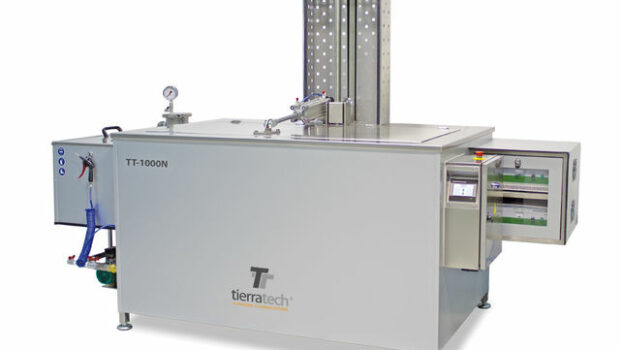Ultrasonic Machining: What Is It And How Is It Related To Ultrasonic Cleaning?
Ultrasonic machining and cleaning are practices that employ a similar set of principles to arrive at diametrically opposed ends. While the latter seeks to remove contaminants from the surface of the work material, the former seeks to remove parts of the work material itself until a desired shape, groove, spiral, finish, or contour is achieved.
Hyperbolic qualifiers like “mega”, “ultra”, and “hyper” are often thrown around willy nilly as part of marketing material. With ultrasonic cleaning, however, this description is well deserved with both of these techniques.
This article will explain the reasoning behind using the word “ultrasonic’ and compare the cleaning and machining applications of the science. We’ll also go over the inner workings of ultrasonic machining and its most popular use cases.
Putting the ‘Ultra” in Ultrasonic
The primary reason why both of these techniques are termed ultrasonic is the fact that they utilize high-frequency soundwaves to achieve their various functions. These soundwaves, despite being extremely powerful, reside outside of the spectrum that our ears can hear.
Ultrasonic cleaning, for example, employs soundwaves that reside between the 20-40 kilohertz spectrum. Here, the soundwaves are produced by the transducer and are carried, through the cleaning solution, to the work material’s surface.
These soundwaves are carried in the form of cavitation bubbles that form in the solution itself. Millions of these cavitation bubbles (per square inch) explode on the surface of the work material, dislodging unwanted contaminants like dirt, dust, grease, lime build-up, and rust.
Ultrasonic machining (USM), on the other hand, is a manufacturing process that involves the removal of material from the surface of a workpiece by the use of an axially oscillating tool. Surrounded by fine abrasive particles, this tool vibrates at a high frequency and a low amplitude.
The similarities between ultrasonic cleaning and machining don’t end at their mechanical underpinnings. They are also both incredibly precise. Ultrasonic cleaning can remove microscopic specs that are invisible to the human eye, while ultrasonic machining can achieve a dimensional accuracy of up to +/- 0.005mm.
Constituent Parts of the Machining System
The main elements of ultrasonic machining equipment are:
Generator/ Power Supply
The power supply is in charge of generating high-frequency alternating current (AC). Just like in ultrasonic cleaning, this power results in sounds within the 20-40 kilohertz range. The power supply is connected directly to the next item on this list, the transducer.
Transducer
The transducers used in ultrasonic machining convert electrical energy from the generator into mechanical vibrations. There are two predominant kinds of transducers used in machining: magnetostrictive and piezoelectric transducers.
The former kind uses ferromagnetic material like nickel alloys placed inside a coil of wire. As alternating current passes through the coil, an alternating magnetic field is created. The vibrational movement is created by magnetostriction and requires water cooling to dissipate waste heat.
The latter kind, piezoelectric transducers, use crystals such as barium titanate instead. These crystals are vibrated when an alternating current is applied. It converts electrical energy to mechanical energy at a much higher rate than the magnetostrictive kind (90% as against 25-30%).
Tool
The tool is usually made of ductile material like mild steel or brass. This helps reduce tool wear. The tool is adhered to its holder by brazing in order to mitigate against fatigue. Importantly, the cavity of impressions products by the tool have the exact same geometry as the tool itself.
Abrasive Slurry Feeder
Remember the fine abrasive particles we spoke about earlier? They’re fed in between the tool and workpiece by the feeder. Usually, this slurry is made of materials like silicon carbide, diamond dust, or boron carbide – mixed in with water or oil.
As a rule of thumb, smaller size grits result in a smoother surface finish while larger grains are great for fast machining. The slurry is carried away as debris during the process and cooled down by an intrinsic cooling system.
How USM Works
The electronic oscillator (or generator) is used to produce the alternating current of an ultrasonic frequency range. This energy is then passed on to the transducer which converts it into mechanical vibrations. The mechanical amplifier then magnifies the vibrational energy for the concentrator.
The abrasive slurry is channeled between the oscillating tool and the work material. It is pumped at such a consistency as to cool down the machining zone. The effectiveness of ultrasonic machining is a combination of three actions:
- The mechanical abrasion by directly hammering the workpiece
- Chipping at the microscopic level due to the free impacting of the particles flying across the machining bit
- Erosion due to cavitation from the slurry stream
Conclusion
Ultrasonic solutions aren’t used for cleaning alone. The technology has simultaneously existed as the backbone of cutting-edge innovation in metal machining.
In both ultrasonic cleaning and machining, high-frequency waves are employed to create the energy required to either clean or machine the workpiece. In the former, this energy exists as cavitation bubbles in the solvent, and in the latter, it exists to be converted into kinetic energy.
It’s clear that whether used in the cleaning or machining of parts, ultrasonic energy allows work to be precise, efficient, and quick.













